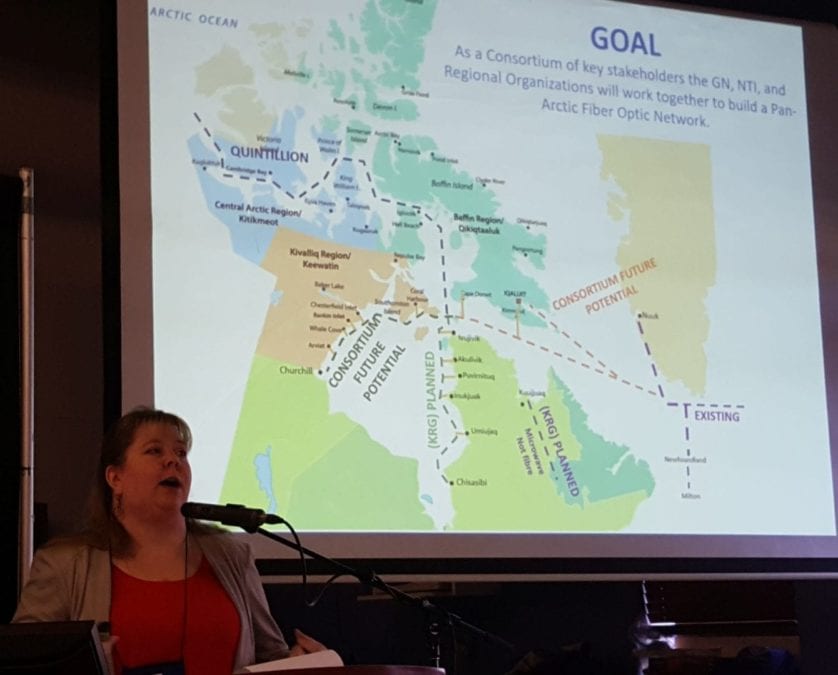A project to install an undersea fibre optic cable from Nuuk to south Baffin Island, given the go-ahead by the federal minister responsible in March following a positive recommendation from the Nunavut Impact Review Board (NIRB), has an uncertain start date.

NNSL file photo
The project involves an undersea fibre optic cable from Nuuk to Iqaluit, Kimmirut and Cape Dorset, and a separate cable from Sanikiluaq to Quebec.
"The proponent intends to conduct cable laying/installation, and construction of shore landings," according to NIRB's written decision.
Community and Government Services (CGS), the department responsible, declined an interview, stating via e-mail it did "not have enough information to provide."
According to the project scope in NIRB's written decision, the work was to take place from May 2019 to December 2020.
"We are still awaiting on confirmations on these timelines, which is why we cannot provide these details to you now. However, we will make sure to get back to you once these confirmations have been established," stated department communications specialist Nasra Esak.
According to a committee of the whole discussion Oct. 31 of last year, the project would cost the Government of Nunavut roughly $30 million, with a hoped-for federal infusion of $90 million – a 25/75 split.
At that time, CGS assistant deputy minister for infrastructure Eiryn Devereaux indicated a business case had been prepared and shared with the federal government.
Arviat North-Whale Cove John Main, who was dubious about the project then, stated via e-mail May 29 that he feels "the department rushed into this project without proper consideration of other options for ownership of the fibre line, such as the private sector and/or development corporations."
"The department indicated that this project would 'pay for itself' but didn’t substantiate that claim, in terms of justifying this project as a government-owned asset. I’m concerned about potential cost overruns and the department's ability to manage a project of this magnitude in addition to the essential infrastructure builds across Nunavut," he adds.
"I will be very surprised if the department can execute this project on time and within budget."
Government, business, NGOs and resident would benefit
Iqaluit Mayor Madeleine Redfern, a long time vocal proponent for connectivity solutions for the capital and the territory as a whole, said it's good news regulatory approval has been obtained.
"There are a number of other important and big considerations, including financing and funding for this project that need to be in place for it to proceed," she stated by e-mail.
"A project of this magnitude requires very specialized expertise to ensure it is properly planned and implemented, so that it is built at the best price, addresses all the technical requirements and associated risks that are inherent of subsea cables, scalable, and this project comes in on time and on budget."
Nevertheless, two Iqaluit MLAs, as well as the mayor, stress the importance of such infrastructure.
"In recent times people across the world have become increasingly connected through the internet, that many now consider access to broadband as a fundamental right," stated Iqaluit-Manirajak Adam Arreak Lightstone via e-mail.
"Nunavut is the only territory or province that does not have a fibre connection in Canada. Given Nunavut’s reliance on satellite connectivity, access to broadband is limited and expensive. The low speed and high costs of internet has affected the delivery of services in both the public and private sector."
Lightstone also notes Iqaluit represents 70 per cent of the broadband usage in Nunavut.
"Removing the capital would alleviate the pressure on the system and increase the internet capacity across the territory."
Iqaluit-Niaqunnguu MLA Pat Angnakak stated she sees nothing but positive about the fibre optic project.
"I think it will help us in all levels of communication, including health who can use the fibre optics to send out medical reports and cases without having to perhaps send the patient down. I think everyone will be looking forward to a better and perhaps cheaper way of communicating with the world," she said.
Lightstone similarly mentioned health, but added the project could also significantly enhance education initiatives across Nunavut.
Hudson Bay MLA Allan Rumbolt thinks Sanikiluaq's connection to Quebec would be good for his constituents.
"It could potentially lower the costs for residents and allow high-speed access for data," he stated.
"With our current system, it's difficult to do online courses because of slow connections. I hear it can take up to 30 minutes just to get online for online courses."
He adds more residents might want to further their education online in Sanikiluaq had fibre connectivity.
Redfern concludes improved connectivity in Nunavut "would make a tremendous difference for all orders of government, business, NGOs (non-government organizations) and residents."